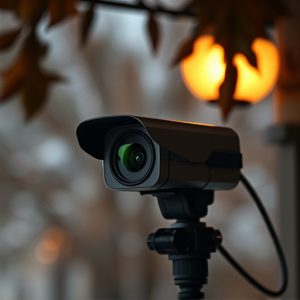Light Reflection: Unveiling Concealed Cameras for Front Door Security
Spy camera detection in everyday spaces like front doors has become crucial due to the prevalence of…….
Spy camera detection in everyday spaces like front doors has become crucial due to the prevalence of concealed cameras. The light reflection technique is a non-intrusive method that leverages reflective surfaces and light behavior to uncover hidden devices, especially micro cameras. By shining a specialized light source at areas like door handles or peepholes, distorted or unusual reflection patterns can indicate a hidden camera's presence. This safe method appeals to home security enthusiasts looking to protect their front doors from covert surveillance. Despite advancements in technology, future solutions should explore advanced imaging techniques and AI algorithms for more accurate detection of concealed cameras integrated into everyday objects.
Uncover the subtle signs of hidden threats with our guide on spy camera detection using light reflection. Learn how this innovative technique, a game-changer in front door security, leverages natural light to reveal concealed cameras. We explore the science behind it, its practical applications for your home, and potential enhancements. Understanding these methods is crucial in today’s digital era, where privacy and safety are paramount, especially when addressing concerns about concealed cameras for front doors.
- Understanding Spy Camera Detection: The Light Reflection Technique
- How Does Light Reflection Help in Identifying Concealed Cameras?
- Practical Applications of the Light Reflection Method for Front Door Security
- Limitations and Future Enhancements in Spy Camera Detection Technology
Understanding Spy Camera Detection: The Light Reflection Technique
Spy camera detection has become an essential practice, especially with the prevalence of concealed cameras in everyday spaces like front doors. The light reflection technique is a non-intrusive method used to uncover these hidden devices. It leverages the reflective properties of surfaces and the behavior of light to reveal any suspicious hardware. When light encounters a smooth surface, it reflects uniformly, but if there’s a camera lens present, the reflection can be distorted or exhibit unusual patterns due to its curved shape.
This technique is particularly useful for identifying micro cameras, which are often tiny and hard to spot with the naked eye. By shining a specialized light source at suspected areas, such as door handles or peepholes, any reflected light anomalies can indicate the presence of a hidden camera. This method doesn’t require any physical tampering with the device, making it safe and effective for home security enthusiasts aiming to protect their front doors from potential covert surveillance.
How Does Light Reflection Help in Identifying Concealed Cameras?
Light reflection plays a pivotal role in identifying concealed cameras, especially those strategically placed for surveillance. When light encounters a hidden camera lens, it reflects off the glass or plastic surface, creating a subtle yet detectable pattern. This phenomenon is particularly useful in scenarios involving front door security, as even miniature cameras positioned within door handles or frames can be revealed through careful observation of light reflections.
By analyzing these reflections, individuals can become more vigilant against potential hidden surveillance devices. For instance, noticing an unusual glow or distortion on a surface may indicate the presence of a lens. This simple yet effective technique empowers homeowners to enhance their front door security by ensuring no concealed cameras are lurking, thus protecting their privacy and safety.
Practical Applications of the Light Reflection Method for Front Door Security
The Light Reflection Method for detecting concealed cameras, particularly focused on front door security, offers a practical and non-invasive approach to enhancing privacy. This technique leverages light reflection patterns to identify any suspicious devices mounted behind or within doors. By casting a specific angle of light onto the door surface, subtle variations in reflections can indicate the presence of hidden cameras, ensuring potential intruders cannot covertly monitor entry points.
This method is valuable for homeowners and security professionals alike, as it allows for proactive measures against unauthorized surveillance. With a simple setup using specialized lighting equipment and advanced analysis software, individuals can safeguard their front doors from Concealed Cameras, promoting a greater sense of security in their homes.
Limitations and Future Enhancements in Spy Camera Detection Technology
Despite significant advancements in spy camera detection technology, several limitations persist. One major challenge is the constant evolution of hidden camera designs; manufacturers continually create more compact and sophisticated devices that can be easily integrated into everyday objects, making them harder to detect. Additionally, the effectiveness of current detection methods heavily relies on line-of-sight visibility, rendering them ineffective in areas with obstructed views or limited access.
Looking ahead, future enhancements should focus on developing advanced imaging techniques that can penetrate obstacles and materials, potentially using terahertz or infrared technology. Improved artificial intelligence algorithms could also be leveraged to analyze video feeds more accurately, identifying subtle patterns indicative of concealed cameras. Moreover, integrating these detection systems with smart home devices could provide real-time alerts for potential hidden cameras in areas like front doors, enhancing privacy security measures significantly.
The light reflection technique offers a promising approach to detecting concealed cameras, particularly for front door security. By utilizing specific lighting angles and patterns, this method can reveal hidden lenses, providing an effective means of identifying potential privacy breaches. While practical applications are already proving beneficial, ongoing research and development in spy camera detection technology will further enhance its capabilities, ensuring a more secure environment for homes and businesses alike. Understanding and adopting these innovations, such as advanced algorithms and improved sensor technologies, will be key to staying ahead of evolving surveillance techniques.


